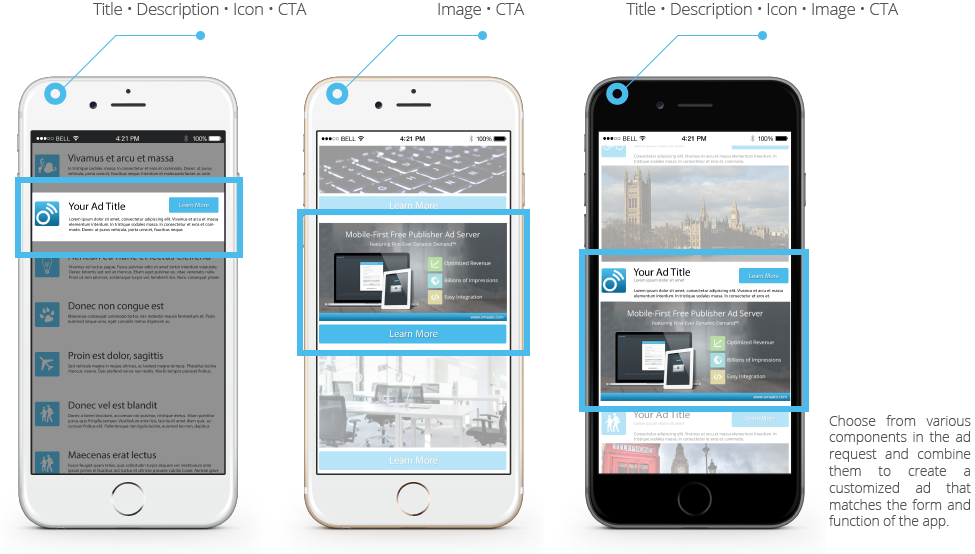
The most effective business strategies don’t focus on push notifications alone to engage with users. In-app messaging is a powerful tool for retention and driving loyalty on mobile.
According to Statista, in-app purchase is the number one source of mobile revenue. When 48.2% of your purchases are from in-app purchases it’s time to take notice.
An in-app message – also known as native app content or in-app notification – is a direct message that displays to your app users only when they are active within the app. In-app gives you the power to react in real-time to your app users, not when databases catch-up 24 hours later.
Our data shows that in-app messaging typically sees higher interaction rates because the in-app audience is already captive. A user doesn’t need to opt-in for in-app, it delivers to your entire user base. It doesn’t even matter if the user is opted-out, in-apps still deliver. You already have your app user’s attention, now is the time to use it.
In-app messaging gives marketers great creativity; the notifications are customisable. They can appear as a banner, pop-up or inline. They are native messages that can pop, slide or blend. They are adaptable to the type of message you want to send; for example, full-screen to let users know about a special offer, or in-line for an app feature. In-app notifications can include images and deep links.
In-app messages and push notifications are usually bundled together. Push notifications are useful of course, but in-app messaging is leading the charge for revenue generation and engagement. Push notifications can be limited in terms of design. Even worse, a poorly timed push can frustrate app users, leading them to delete. Here we’ll focus on some of the benefits of in-app notifications.
In-app provides advantages like few other channels. One of the biggest advantages to in-app messaging is when you can combine it with an event trigger, such as a session open or a purchase. Following the if-this-then-that framework, in-apps can be triggered by a specific user behaviour, tap or an app event. This is real-time contextualisation and hugely valuable for app owners. There is little reliance on vanity metrics like “engagements.” In-app messaging delivers a clear yes or no action providing distinct, actionable results.
The following in-app messaging guidelines come from a lot of experience. Mobile marketing automation is still relatively new. Utilising data from millions of mobile interactions over time, we’ve created a series of guidelines for leveraging in-app to deliver bigger turnover and increase user loyalty.
In-app is a gift for marketers. It allows you to communicate directly with highly engaged users. What mobile customers want most is information and offers about products when they need them. In-app becomes the next best offer at the right time. We’ve outlined some useful tactics to drive better engagement through in-app messaging:
- A clear, definable goal should be your first step for in-app messaging success. Understanding your users and aligning with your funnel stages serves to better your in-app marketing.
- A classic error for marketers is sending in-app messaging to your entire audience with no segmentation. This is a spray-and-pray approach. Marketing is only as effective as its targeting. Broadcasting one-size-fits-all messaging can be an expensive error. It fails to take into account that your users are individuals. Let’s look at a sports betting app example. Where is the value in delivering a message based on horse racing to a user has never tapped on that sport? This leads to churn. We’ve collected more use cases for in-app messaging specifically for sports betting here.
- Keep your messaging clear and succinct. Use a single call-to-action. Make it clear what you want them to do – reload a cart, place a bet or discover a new feature – and make it easy for them to complete it. Broadcast style in-app is just as bad as broadcast style push. It is spammy and puts users off your app and your brand.
- Always, always include a deep link. Make it easy for your user to actually complete the CTA you are giving them. “Buy now” should lead to a product page, “Bet now” should go to a filled bet slip.
- In-app messaging is key to combatting cart abandonment. Remind users to continue shopping, or give an extra incentive to complete their purchase in the form of a discount or free shipping.
- Use in-app to merge your onboarding journeys and share the value your app offers. Onboarding is a prime opportunity to showcase what your app can do. Utilise images and text to educate your app users. Guide them through the best journey of your app.
- Automation is your ally here for in-app. It’s there to do the hard work. Mobile marketing automation allows you to target based on what your users are doing, engage across relevant channels, (mobile or otherwise) and gives CRM and marketing teams the time to focus on A/B testing, data analysis, and mobile journey planning.
- Request an app review. Trigger an in-app after a recent purchase in a retail app or a winning bet in a sports betting app to request an app store review, when they have just had a positive app experience.
With a clear in-app messaging strategy you’ll be one step closer to genuine engagement with your app users and better retention and monetisation results. In-app messaging is geared towards the uniqueness of app users and is flexible enough to serve everyone from generation Xers to Millennials.












